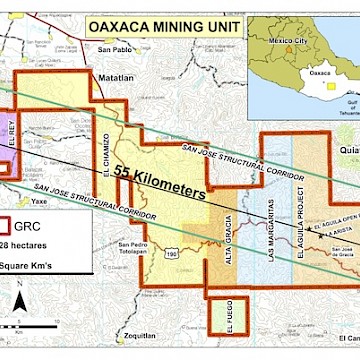Oaxaca Mining Unit Exploration
Gold Resource Corporation has consolidated and controls 100% of a large, highly prospective property position in the southern state of Oaxaca, Mexico. The Company's six properties now encompass over 68,000 contiguous hectares (684 square kilometers), including 55 kilometers of the regional "San Jose structural fault corridor" which trends North 70 West.
The Company believes the mineralization along the San Jose structural fault corridor is related to the Cocos tectonic plate subducting the North American plate. As the Cocos plate is subducted, it breaks and is partly re-melted into the surrounding mantle. Any faults overlying the North American plate are exploited by the molten magma, which under immense pressure is forced to the surface forming volcanos. It is these volcanic events that have deposited high-grade mineralization along this fault corridor.
The Company discovered the Arista deposit at its El Aguila Project in 2007, a high-grade epithermal system containing gold and silver, as well as the base metals copper, lead and zinc. This polymetallic deposit is located at the far southeastern portion of the Company's land position. The Arista deposit entered production March 2011.
Gold Resource Corporation has also discovered a high-grade gold vein system at its El Rey property, 55 Km's northwest from El Aguila along the San Jose structural fault corridor. Drilling at El Rey has returned results as high as 132.5 grams per tonne gold over 1.0 meter. The Company also announced in 2013 initial drill results from its centrally located Las Margaritas concession, which included 2.85 meters of 27.90 g/t gold and 2,600 g/t silver. Surface sampling and airborne geophysics have generated multiple targets between El Aguila and El Rey warranting additional exploration along this 55 kilometer mineralized structural fault corridor.

